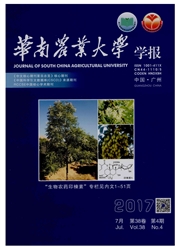

 中文摘要:
中文摘要:
【目的】探讨传统农业中利用芝麻作为开荒作物的作用机理。【方法】采用大田种植方式,在南方红壤新垦荒地以芝麻作为先锋作物,大豆和玉米作为对照,调查不同作物对后茬作物玉豆和萝卜产量、土壤理化性质以及田间杂草的影响。【结果】新垦荒地种植芝麻对后茬玉豆和萝卜单株产量增产率分别为44.25%和148.48%;对土壤p H、有机碳和速效磷含量有增加效应,使土壤碱解氮和速效钾分别减少了89.93%和47.95%;种植芝麻后未发现原生境中的杂草粗耳草,但出现优势杂草凹头苋和三叶鬼针草;杂草种类和生物量受后茬作物种类的影响差异较大,其中芝麻-自然长草处理杂草种类为5.67种,与芝麻-萝卜处理11.67种和芝麻-玉豆处理10种相比差异达显著水平,杂草的地上部净质量为萝卜(1 639.13 g·m^-2)〉玉豆(976.89 g·m^-2)〉自然长草(944.13 g·m^-2);芝麻-长草与长草-长草处理相比,杂草种类由4种增加到5.67种,但杂草生物量由2 698.6 g·m^-2减少到944.13 g·m^-2。【结论】芝麻可以提高后茬作物产量,对杂草的生长有抑制作用,适宜作为开荒作物。芝麻凋落物和残茬易腐解,导致土壤有机质和速效磷增加,这可能是后茬作物增产的主要原因。
 英文摘要:
英文摘要:
【Objective】To explore the mechanism of using sesame for cultivating wasteland in traditional agriculture land.【Method】Sesame was planted in the virgin land with red soil in the south area as the pioneer crop,the controls were Glycine max and Zea mays.The yield of afterreap crops,Raphanus sativus and Phaseolus coccineus,physicochemical characteristics of soils and changes of weeds were studied.【Result】The yield of R.sativus and P.coccineus increased,and the increase rate was 44.25%and 148.48% respectively.The contents of organic C and available P,and p H in the soil increased.The contents of available N and available K decreased by 89.93% and 47.95% respectively.The dominant weed Saxifraga stolonifera in virgin land was not found after planting sesame,but Amaranthus blitum andBidens pilosa became dominant.The species and biomass of weeds were affected by afterreap,and there were significant differences of weed species between sesame-radish(11.67 species) or sesame-P.vulgaris(10 species) and sesame-natural grass(5.67 species).Compared with grass-grass,the number of weed species of sesame-grass treatment increased from 4 to 5.67 species,but biomass reduced from 2 698.6 to944.13 g·m^-2.【Conclusion】Sesame,which can enhance afterreap crop yield and inhibit weed growth,is suitable for cultivating wasteland.The fact that the litter and stubble from sesame are easily decomposed can increase organic C and available P contents in soil as well as afterreap crop yield.
 同期刊论文项目
同期刊论文项目
 同项目期刊论文
同项目期刊论文
 期刊信息
期刊信息
